Ensuring Good Performance Strategies: Striving for the "Triple Play"
Ensuring Good Performance Strategies: Striving for the "Triple Play"
For those who have followed this blog, one of the most researched backed uses of the Motion Guidance Clinician Kit is providing an External Focus (EF) of attention during movement. Combining EF with immediate visual feedback can provide accelerated learning of motor skills acquisition and performance for any user. But recently, I was at the Combined Sections Meeting of the APTA in San Antonio, USA and had the privilege to listen to a talk by Gabrielle Wulf (University of Las Vegas, NV) on the recent advances in Motor Learning.
Gabby Wulf (if she’ll pardon the casual reference, but she was introduced as such at CSM) is one of the front leaders in motor learning and performance research in the past 25 years. She has been the lead author of both books and professional journal publications. Gabby spoke on new developments in Motor Performance and retention and what she was referring to as the “Triple Play”. This blog will give an overview of her publication and the concepts behind this Triple Play for Motor Learning and performance.
HOW YOU CAN IMPROVE YOUR CLINICAL INTERACTIONS BY ADDING “TRIPLE PLAY” CONCEPTS
First, there needs to be an understanding of what the definition of motor performance is for this blog, which I will define as “the ability to learn and retain a motor skill in a controlled environment over several trial and repeated sessions.”
Now lets talk about three separate motor learning strategies, discussed in the study by Gabriel Wulf:
-
Enhanced Expectations
-
Autonomy Support
-
External Focus of Attention.
I will break these down into each individual section and then come back around to the results of the study.
Enhanced Expectations:
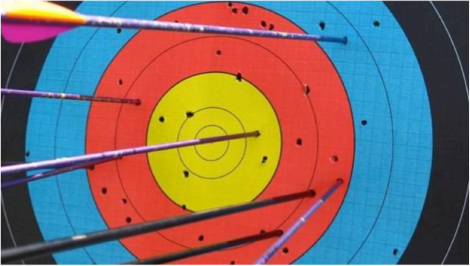
This concept refers to the description of augmented social-comparative feedback in a positive form. It is essentially not setting definition on success, and allowing the person to define success through performance.
Lets use an example of Enhanced Expectations with an archer and target: This concept refers to the description of augmented social-comparative feedback in a positive form. It is essentially not setting definition on success, and allowing the person to define success through performance.
A typical target is made up of colored circles in which the smallest circle and color might represent the “best” attempt. The participant might automatically assume that certain colored rings are more successful than others. If we consider this example of the multi-colored target.
One way of implementing Enhanced Expectations to shooting at this target would be to give feedback that ALL attempts are successful if they simply hit the target (or using a target with all one color). This lets the archer then decide for themselves what their success means as they become more accurate, and their motivation is based on their experience as they dictate how accurate they want to become and challenge themselves.


Autonomy Support:
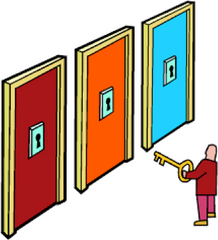
External Focus of Attention:
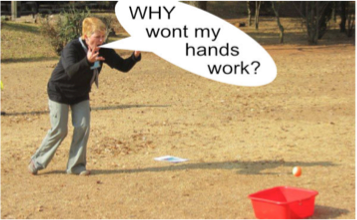
This concept has been well documented in numerous studies as showing superior learning and retention for motor learning compared to Internal Focus. It is essentially directing attention externally during the task.
Changing our thoughts and our words to describe the goals of the movement rather than the body actions that are required to complete the task can be difficult for the practitioner, and may take some creativity, but doing so allows optimal learning. Being aware of how we give cues and feedback can be critical to performance.

THE RESEARCH:
The design of this study included 4 groups with various feedback styles implemented (click the slide to the right to link):
- Enhanced Expectations - Autonomy Support (EE-AS)
- Enhanced Expectations - External Focus (EE-EF)
- Autonomy Support - External Focus (AS-EF)
- Autonomy Support - Enhanced Expectations - External Focus (AS-EE-EF)
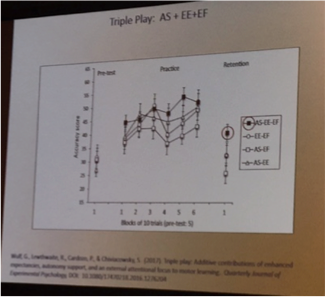
Participants threw balls at a target with their non-dominant arm. In the Enhanced Expectations conditions, they received positive social-comparative feedback. In the Autonomy Support conditions, they were allowed to throw with their dominant arm on trial blocks chosen by them. In the External Focus conditions, participants were asked to focus on the target. On a delayed retention test, the AS-EE-EF group outperformed all other groups (click on photo for your hyperlink to the article abstract).
The findings provide evidence that enhanced expectancies, autonomy support, and an external focus can all be combine to optimize motor learning.
These results should give us further awareness into how we can maximize the learning, performance and retention for our patients.
LETS USE THESE FEEDBACK CONCEPTS IN A CLINICAL EXAMPLE:
Mr. Jones is 3 weeks after his Total Knee surgery. He is struggling with quad lad during SLR, poor quad set initiation, and lacking 8 degrees of active extension.
ENHANCED EXPECTATIONS:
Mr. Jones is laying supine on the plinth working on extension:
-
Option A) "I want you to straighten your knee, we want your knee totally flat on the plinth. Squeeze your quad muscle and try to get the back of the knee flat and hold for 3 seconds".
- Option B) (small towel placed under knee laying supine) "If you feel pressure on this towel, you are successful in this exercise. Practice this for 3 seconds on, 5 seconds off, over the next few minutes".
Option B uses Enhanced Expectations : Mr. Jones gets to advance himself based on what he is feeling and how he is performing.
AUTONOMY SUPPORT
Mr. Jones is now moving on to doing some walking, he is using his walker

- Option B) "Were going to do some walking, and you get to choose the distance, I will be timing us. We will do a few bouts of this. You can go where you like, down the hall, or stay in the clinic. Hold your walker how you feel most secure, though as you advanced you should depend on it less and its easier to walk erect if the walker is closer to you".
Option B uses Autonomy Support: Mr. Jones gets to choose how he performs the exercise, and he can modify this based on his experience. His performance isn’t pre-determined or strictly defined, he is in control of this.
EXTERNAL FOCUS OF ATTENTION:
Mr. Jones returns for the next session, and he thinks his leg is getting straighter but not sure.
- Option A) "Mr Jones, you really need to be squeezing your quad muscle with this. Lock it out. Squeeze that quad and straighten your leg".
- Option B) "Mr. Jones I want you to watch your knee cap and try to elevate it. Your goal is to see some wrinkles above the knee cap, then hold these wrinkles for 3 seconds".
*Alternatively, if you have a visual feedback set up, the external feedback addition is pretty simple: “Mr. Jones I want you to make this laser light go further down your sock every time you attempt to straighten the leg”.
Option B uses External Feedback: Mr. Jones isn’t trying to internally and cognitively think of his body and what its doing, he is able to focus on something else out side of the body, that is directly related to the task in a way that allows him to judge visible success.
Another simple example of applying these concepts with the Motion Guidance device is during an exercise such as the “bird-dog”. I have started to change how I instruct patients during this simple exercise in clinic.
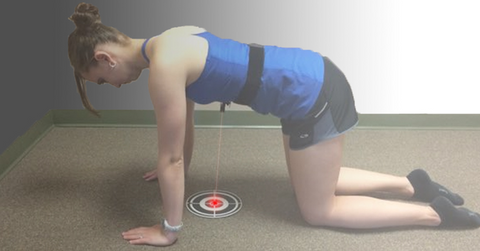

Classically, I place the drop target (black and white bull’s-eye) under the patient with the laser turned on. I have now started to not give a pre-determined goal to the patient during the exercise. But rather, I use Enhanced Expectations to give delayed feedback that keeping the laser on any part of the target during the exercise was a very good result (instead of suggesting that the closer to the center of the target the laser remained was the goal).
Not surprisingly, the patient independently wants to improve their precision during the task in subsequent blocks. Then, I give Autonomy Support by allowing the patient to determine how many repetitions they want to do on their first set. Then I pay attention. How is their performance? What strategies is the patient using to get this performance? The real beauty is that External Focus is already provided to the patient by the laser. LET THE LEARNING AND RETENTION BEGIN!
Hopefully this blog has given you some extra considerations about the strategies we are using with our patients during motor skills training….and EVERYTHING is really some component of motor skill learning.
-Eric



Leave a comment
Please note, comments must be approved before they are published